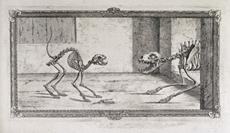The human skeleton has multiple meanings in history: medical, scientific, symbolic, religious. These perceptions have shifted over time and place, and as anatomical study rose to prominence in early modern Europe, they continued to coexist. Skeletons, moreover, were crafted objects prepared from dead human bodies. Between the sixteenth and the mid-eighteenth centuries, a critical juncture in the history of anatomy, the skeleton became a scientific object while retaining long-held connotations as symbols of death and as relics. These symbolic roles continued to be evident in illustrations of skeletons, whether in anatomical textbooks and atlases or in manuals for artists.
Examining interactions between artists and anatomists illuminates the processes by which the act of dissection was transmitted to the pen and the page, and the tension between particularity and exemplarity. The physical skeleton and its display form the other half of this story. In this period, the physical skeleton became a prized commodity among men of science. Practices and techniques evolved in the seventeenth century as the skeleton became increasingly essential to anatomical instruction, and construction of a skeleton became as much an art as a science, with attention paid to aesthetic values such as whiteness and smoothness as well as to anatomical accuracy.
Yet in cemeteries, the bones of the dead were given little respect. Sorting out the differing valuations among anatomical skeletons, relics, and charneled bones was another task of this project. The display of human skeletons in cabinets began in the mid-seventeenth century in the context of natural history rather than medicine: human bones appeared side by side with animal bones. What was the role of artists and aesthetics in this process of construction and display?

